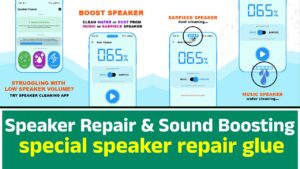Speaker Repair & Sound Boosting
1. Deep Speaker Issues and Solutions
A) Physical Damage
- Torn Speaker Cone:
→ Use special speaker repair glue (like Aleene’s Tacky Glue). Paper patches work best for small tears. - Loose Voice Coil:
→ Realign carefully. If coil is burnt, you must replace it — rewinding coils manually is very difficult!

B) Electrical Failures
- Broken Solder Joints:
→ Resolder connections. Use a low-temperature soldering iron to avoid burning the board. - Blown Capacitors:
→ Look for swollen or leaking capacitors on circuit boards. Replace with the exact same voltage rating.
C) Bluetooth or Wireless Problems
- Firmware Issues:
→ Check the brand’s website for firmware updates for your Bluetooth speaker. - Antenna Breakage:
→ Open the speaker and check if the antenna wire is loose or broken. Solder or replace it.
2. Pro Techniques to Boost Sound Quality
Physical Boost Tricks:
- Reflective Surfaces:
Place speakers near a wall (not directly against it) to amplify bass naturally. - Isolation Pads:
Use foam pads under speakers to reduce vibrations and sharpen sound clarity. - Speaker Placement “Rule of Thirds”:
Speakers sound better when not stuck in corners — place them about ⅓ of the room length from walls.
Electrical Boost Tricks:
- Use a DAC (Digital-to-Analog Converter):
It makes audio signals cleaner before they reach the speaker = better quality! - Get a Preamp:
Preamplifiers boost the source signal (from phones, PCs) so the final sound is louder and clearer.
3. Boost Volume Without Damaging the Speaker
Never crank volume to 100% — distortion happens after 85%-90%.
Use an equalizer to boost specific frequencies (like bass or treble) instead of raw volume.
Avoid bass boost overload — excessive bass strains small speaker cones.
Upgrade power cables if using wired speakers — thicker wires = less power loss = better sound.
4. Hidden DIY Tricks
- Homemade Dust Caps:
Lost the dust cap of your speaker? You can 3D print a new one or use a plastic bottle cap with glue! - Fixing Water Damage:
→ Bury speaker parts (NOT battery or circuit board!) in uncooked rice or silica gel for 48 hours.
→ Don’t use hair dryers or ovens — heat can warp plastics and damage magnets. - Enhancing Old Speakers:
→ Replace the internal capacitors and wiring even if they aren’t broken — this restores old speakers almost like new!
5. Apps for Boosting Sound (Best 2025 List)
| App Name | Platform | Features |
|---|---|---|
| Boom 3D | Windows, Mac | 3D Surround, Bass Boost |
| Equalizer APO | Windows | Professional-grade EQ |
| FxSound | Windows | Real-time sound enhancement |
| VLC Media Player | Windows, Mac, Mobile | Boost audio up to 200% |
| SoundID Listen | Android, iOS | Personalized sound tuning |
6. Expert-Level Maintenance Tips
- Keep Speakers Upright:
Some speakers have fluid inside voice coils — tilting them can misalign parts over time. - Check for Software Updates:
Smart speakers (like JBL, Sony, Alexa) often improve sound with firmware updates. - Clean Ports Carefully:
Use a wooden toothpick (NOT metal) to clean 3.5mm audio jacks and USB-C ports. - Battery Maintenance (for Bluetooth Speakers):
Don’t let the battery die to 0% too often — recharge at 20%-30% to keep battery health strong.
7. When Not to Repair
Sometimes, fixing is not worth it if:
- The cost of repair parts is over 50% of the price of a new speaker.
- Internal magnets are cracked (very rare but serious).
- Severe water damage to PCB boards (white corrosion spots inside).
8. Bonus: How to Make a Cheap Speaker Sound Premium
- Use an external DAC or amp — even a cheap $20 amp can massively boost clarity.
- Switch to lossless audio formats (like FLAC instead of MP3) when playing music.
- Optimize your music player settings (enable “Hi-Fi” or “High Quality” modes).
- Upgrade Bluetooth codecs:
Choose devices that support aptX HD or LDAC for better wireless sound.
Final Tips
- Be patient when repairing speakers — rushing can cause more damage.
- Regular cleaning and safe usage can make even a cheap speaker last for 5–7 years!
- Sound boosting is part art, part science — experiment with placement, settings, and upgrades to find your perfect setup!
